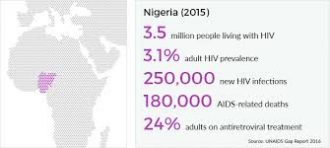As at today, total number of Nigerians living with HIV/AIDS is 2,600,000. Adults between the ages of 14 and 49 have the highest percentage according to the numbers showed by this free hiv test that many people have taken.

Women living with HIV/AIDS in Nigeria of today number up to 1,400,000, while children number up to 220,000. Up to 170,000 Nigerians have died from HIV/AIDS. Number of orphans produced as a result is up to 1,200,000.
The above is the current statistics. However, let us go down history lane to discover how Nigeria came to be scourged by HIV/AIDS as it is today.
The very first two cases of HIV in Nigeria were detected in 1985. It was later reported in 1986 at the International AIDS conference.
Up to 6 more cases were detected in 1987. This was when the Nigerian government decided to establish National AIDS Advisory Committee. Later, the National Expert Advisory Committee on AIDS (NEACA) was established.
Response by the Nigerian government to HIV was slow at the initial stage. The Federal Ministry of Health made its very first real attempt to assess the AIDS situation in Nigeria in 1991, several years after HIV was first detected in Nigeria.
According to the result generated by the Federal Ministry of Health, up to 1.8% of the Nigerian population was infected with HIV. Subsequently, the percentage rose to 3.8% 2 years later; that was in 1993. In 1998 however, up to 4.5% was recorded.
Olusegun Obasanjo however made HIV prevention, treatment and care one of the primary concerns of his government when he became president in 1999. This brought about the establishment of National Action Committee on AIDS (NACA).
A 3-year HIV/AIDS Emergency Action Plan (HEAP) was also set up by the Obasanjo administration in 2001. The Organization of African Unity’s very first African Summit on HIV/AIDS, Tuberculosis and Other Related Infectious Diseases was held in 2001 by the Obasanjo administration.
The government later developed a new framework in 2005 to cover 2005 to 2009. It was estimated in 2006 that only 10% of men and women infected with HIV were been given treatment at the STD health clinics. The report also stated that only 7% of pregnant women infected with HIV are being given treatment towards reducing mother-to-child transmission of the viral infection.
National Strategic Framework was launched by NACA in 2010 to cover from 2010 to 2015. This program required about N756 billion to enable implementation.
Some of the goals of the program was to reach up to 80% of adults that are sexually active and to reach up to 80% of those among the population that are mostly at risk. The program intended to provide the required HIV counseling and testing for these individuals by 2015.
Furthermore, the program intended to ensure up to 80% of the adults eligible receive ART by the year 2015. It also intended to ensure up to 100% of children eligible for it are being given ART. Generally, the program intended to make available quality care and support services to minimum of 50% of these individuals by the year 2015.
The United Nations Development Programme (UNDP) rated Nigeria to be at number 158 out of 177 among countries successfully fighting the scourge of HIV/AIDS.